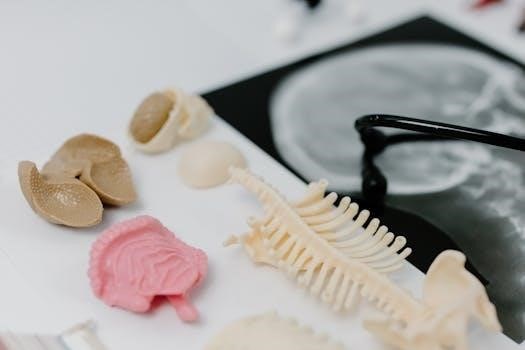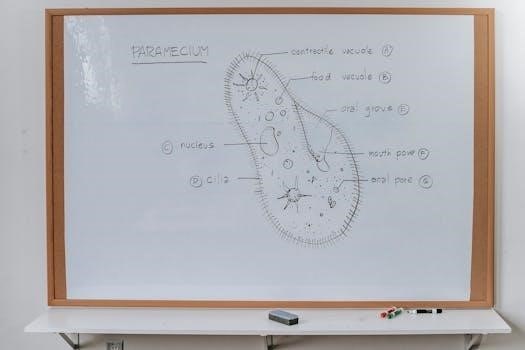Availability of Answer Keys
Access to answer keys for anatomy and physiology lab manuals is often restricted to instructors. This is to prevent students from having access to the solutions before completing their work. Online platforms or learning management systems may provide these keys.
Instructor-Only Access to Answer Keys
To maintain academic integrity, answer keys for anatomy and physiology lab manuals are typically available only to instructors. This controlled access ensures that students engage with the material and do not simply copy answers. Instructors may request access through specific channels, such as contacting the publisher or using an institutional platform. This practice protects the learning process, allowing students to benefit from their individual efforts in the lab exercises.

Types of Lab Manuals
Anatomy and physiology lab manuals come in different versions, such as a main version and a cat version. These versions may cater to different course requirements or resources.
Main Version vs. Cat Version
The distinction between the main version and the cat version of an anatomy and physiology lab manual often lies in the specific dissection specimens used. The “cat version” typically includes detailed instructions and exercises related to cat dissections. The “main version” may use other models or species, offering a broader perspective. Both versions aim to reinforce anatomical and physiological understanding, but with varying practical applications. The choice between versions usually depends on the course’s focus and available resources.
Editions and Authors
Several editions of anatomy and physiology lab manuals exist, often authored by experts like Marieb and Smith. Each edition may contain updated exercises and content. Different authors may present information in unique ways.
Marieb’s Lab Manuals
Elaine N. Marieb is a prominent author of anatomy and physiology lab manuals, often used in college courses. Her manuals are known for their clear, concise, and student-friendly writing style. Different editions of Marieb’s lab manuals may include exercises, activities, and experiments to enhance the understanding of anatomical structures and physiological concepts. The manuals are often published by Pearson Higher Education and include materials for both the main and cat versions.
Other Authors and Editions
Besides Marieb, other authors also contribute to anatomy and physiology lab manuals, such as Terry R. Martin and Catharine C. Whiting. These manuals often come in various editions, each with potential revisions and updates. Different authors might present content in slightly different ways, which can cater to different learning styles. It’s important to check the specific edition and author when seeking answer keys or solutions as they may not be interchangeable.
Accessing Answer Keys
Answer keys for lab manuals are typically found on online learning platforms or through textbook solution websites. Instructor-provided resources and specific textbook companion sites are also common avenues for access.
Online Platforms and Learning Systems
Many educational institutions utilize online platforms and learning management systems where instructors may upload answer keys for anatomy and physiology lab manuals. These platforms often require student login credentials, ensuring that only authorized users, primarily instructors, have access to the solutions. This method provides a secure and controlled way to distribute answer keys, maintaining academic integrity and student accountability. Checking your institution’s specific online portal is the recommended first step.
Textbook Solution Websites
Several websites offer textbook solutions, including those for anatomy and physiology lab manuals. These platforms often provide step-by-step answers and detailed explanations for exercises. However, it’s crucial to verify the credibility of these websites, as not all resources are accurate or reliable. While these websites can be useful for understanding concepts, they should be used responsibly and ethically, focusing on learning rather than simply copying answers. Some sites may require subscriptions to access solutions.

Content of Answer Keys
Answer keys for anatomy and physiology lab manuals typically include solutions to chapter exercises. They often provide detailed explanations and step-by-step guides to assist students in understanding the material.
Solutions to Chapter Exercises
The primary function of answer keys is to provide accurate solutions to all chapter exercises found within the anatomy and physiology lab manual. These solutions are designed to help students assess their understanding of the material covered in each chapter. They often include step-by-step answers to numerical problems or detailed explanations of concepts tested by the exercises. This allows students to check their work and identify areas where they may need further study or clarification. These are very important for self-assessment.
Detailed Explanations and Step-by-Step Guides
Beyond just providing the correct answers, answer keys often include detailed explanations and step-by-step guides. These are designed to help students understand the reasoning behind each answer. This is especially helpful for complex problems or concepts where simply knowing the final result is not sufficient for learning; The step-by-step guides walk students through the process, breaking down the problem into manageable parts. This enhances comprehension and allows them to learn how to approach similar questions in the future.
Lab Manual Content
Lab manuals often contain exercises on directional terms, requiring students to label anatomical structures. They also include histology practice, which involves identifying tissues under a microscope, with corrections provided.
Exercises on Directional Terms
Anatomy and physiology lab manuals frequently include exercises focused on directional terms. These exercises utilize torso models, requiring students to identify and label anatomical structures using terms like superior, inferior, anterior, posterior, medial, and lateral. Students practice applying these terms to understand the relative positions of body parts. These activities help in building a foundational understanding of anatomical language and spatial relationships within the human body. The practical application of these concepts is key to mastering anatomical terminology.
Histology Practice and Corrections
Lab manuals often incorporate histology practice, where students examine tissue samples under a microscope. This includes identifying different tissue types and their components. It is crucial for instructors to be aware of potential errors in answer keys, particularly in areas like digestive and respiratory histology practice. Corrections might be needed due to offsetting or automatic numbering issues. These corrections should be communicated clearly to students to ensure accurate learning. Proper identification of tissues is essential to understanding the function of different organs.
Digital Formats
Lab manuals are often available in eBook formats such as ePub, PDF, and MOBI. These digital formats provide compatibility with various devices, enhancing the reading experience with interactive features.
eBook Formats and Compatibility
Anatomy and physiology lab manuals are frequently offered in various digital formats to suit different user needs. These formats often include popular options like ePub, PDF, and MOBI, ensuring compatibility with a wide array of devices such as tablets, smartphones, and computers. This flexibility allows students to access their lab materials conveniently, regardless of their preferred device. The use of standard formats also ensures that the content is displayed correctly, maintaining the integrity of diagrams and text.
Additional Resources
Students can find online lab manuals and textbook solutions for extra help. Expert assistance is also available through various platforms, providing support for difficult concepts and exercises.
Online Lab Manuals
Several online platforms offer digital anatomy and physiology lab manuals, often providing interactive exercises and resources. These digital versions can be accessed through various devices and may include enhanced features such as embedded videos and simulations. Many institutions utilize learning management systems, offering access to these digital materials. Some resources are freely available, while others may require a subscription or access through an educational institution. These online resources aim to enhance the learning experience by providing interactive and easily accessible materials.
Textbook Solutions and Expert Help
Numerous websites and platforms offer textbook solutions for anatomy and physiology lab manuals. These resources provide step-by-step answers and detailed explanations for exercises and problems. Expert help is also available through online tutoring services, offering personalized assistance to students. These services aim to guide students through complex material and provide clarity on difficult concepts. Many of these platforms boast large libraries of solutions and expert explanations, assisting students in understanding key concepts and improving their comprehension.

Textbook Publishers
Pearson Higher Education is a prominent publisher of anatomy and physiology lab manuals. They offer a variety of editions and versions, often accompanying their core textbooks. Other publishers may also provide related materials.
Pearson Higher Education
Pearson Higher Education is a major publisher of anatomy and physiology lab manuals, including those by Marieb. They provide various editions and versions, often linked with their core textbooks. These manuals are frequently used in college-level courses and may include online components. Pearson is known for its comprehensive educational materials and resources, catering to both students and instructors. They offer lab manuals in both print and digital formats, allowing flexible learning options for the users.

Use in Healthcare Professions
Healthcare professionals utilize anatomical terminology and understanding of homeostasis from lab manuals in daily clinical practice. This foundation is crucial for accurate diagnoses and treatments across various fields.
Application of Terminology and Homeostasis
The precise use of anatomical terminology, learned through lab manuals, is vital for healthcare professionals to communicate effectively and accurately when describing patient conditions. Understanding homeostasis allows clinicians to assess and address imbalances in the body’s systems, crucial for diagnosis and treatment. These principles underpin daily tasks, from patient charting to performing complex medical procedures. The ability to apply these concepts is fundamental in many healthcare fields, ensuring patient safety and optimal care delivery.
